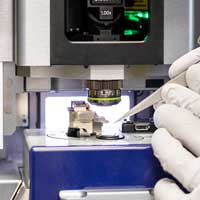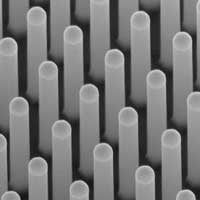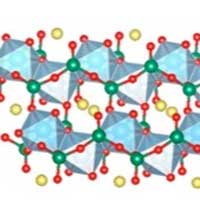 To help turbocharge spintronics, condensed matter physicists have developed a method for terahertz waves to convert spin excitations into electrical signals.
To help turbocharge spintronics, condensed matter physicists have developed a method for terahertz waves to convert spin excitations into electrical signals.
Wednesday, January 29, 2020
First successful generation and detection of pure spin currents in antiferromagnetic materials
 To help turbocharge spintronics, condensed matter physicists have developed a method for terahertz waves to convert spin excitations into electrical signals.
To help turbocharge spintronics, condensed matter physicists have developed a method for terahertz waves to convert spin excitations into electrical signals.
Hybrid technique to produce stronger nickel for auto, medical, manufacturing
 Researchers have created a hybrid technique to fabricate a new form of nickel that may help the future production of lifesaving medical devices, high-tech devices and vehicles with strong corrosion-resistant protection.
Researchers have created a hybrid technique to fabricate a new form of nickel that may help the future production of lifesaving medical devices, high-tech devices and vehicles with strong corrosion-resistant protection.
Researchers' golden touch enhances quantum technology
 Scientists discovered a new platform for quantum technologies by suspending two-dimensional crystals over pores in a slab of gold. This new approach may help develop new materials for secure communication and sensing technologies based on the unique laws of physics at the atomic levels.
Scientists discovered a new platform for quantum technologies by suspending two-dimensional crystals over pores in a slab of gold. This new approach may help develop new materials for secure communication and sensing technologies based on the unique laws of physics at the atomic levels.
Coupled quantum dots may offer a new way to store quantum information
 Researchers have for the first time created and imaged a novel pair of quantum dots -- tiny islands of confined electric charge that act like interacting artificial atoms. Such 'coupled' quantum dots could serve as a robust quantum bit, or qubit, the fundamental unit of information for a quantum computer.
Researchers have for the first time created and imaged a novel pair of quantum dots -- tiny islands of confined electric charge that act like interacting artificial atoms. Such 'coupled' quantum dots could serve as a robust quantum bit, or qubit, the fundamental unit of information for a quantum computer.
A nanoscale lattice of palladium and yttrium makes for a superlative carbon-linking catalyst
 A group of materials scientists has shown that a palladium-based intermetallic electride can improve the efficiency of carbon-carbon cross-coupling reactions. Their findings point the way to a more sustainable world through catalysis.
A group of materials scientists has shown that a palladium-based intermetallic electride can improve the efficiency of carbon-carbon cross-coupling reactions. Their findings point the way to a more sustainable world through catalysis.
It's closeness that counts: how proximity affects the resistance of graphene
 Researchers investigated the influence of the underlying crystal on graphene's electrical resistance. Contrary to previous assumptions, results show that the process known as the 'proximity effect' varies considerably at a nanometre scale.
Researchers investigated the influence of the underlying crystal on graphene's electrical resistance. Contrary to previous assumptions, results show that the process known as the 'proximity effect' varies considerably at a nanometre scale.
Stress test reveals graphene won't crack under pressure
 Researchers have discovered that the carbon-based material can withstand more than one billion cycles of high stress before breaking.
Researchers have discovered that the carbon-based material can withstand more than one billion cycles of high stress before breaking.
Cheap nanoparticles stimulate immune response to cancer in the lab
 Researchers have developed nanoparticles that, in the lab, can activate immune responses to cancer cells. If they are shown to work as well in the body as they do in the lab, the nanoparticles might provide an effective and more affordable way to fight cancer.
Researchers have developed nanoparticles that, in the lab, can activate immune responses to cancer cells. If they are shown to work as well in the body as they do in the lab, the nanoparticles might provide an effective and more affordable way to fight cancer.
Microswimmers swim faster over slippery surfaces
 Tiny self-propelling spheres, measuring only micrometers, move faster over a hydrophobic silicone surface than they do over hydrophilic glass.
Tiny self-propelling spheres, measuring only micrometers, move faster over a hydrophobic silicone surface than they do over hydrophilic glass.
Unexpected behaviour of the material: From 2D crystal to 1D wire
 No volume, not even a surface: a one-dimensional material is like a wire and has properties that are completely different to its 3D counterpart. Physicists have now discovered a system that, at warmer temperatures, forms self-organized wires consisting of only one row of individual atoms.
No volume, not even a surface: a one-dimensional material is like a wire and has properties that are completely different to its 3D counterpart. Physicists have now discovered a system that, at warmer temperatures, forms self-organized wires consisting of only one row of individual atoms.
Theoretical study points to jade-like materials as quantum spin liquids
 This exotic liquid-like state of matter in which magnetism never freezes could give rise to high-temperature superconductivity and form the basis for quantum computing.
This exotic liquid-like state of matter in which magnetism never freezes could give rise to high-temperature superconductivity and form the basis for quantum computing.
Optical vacuum cleaner can manipulate nanoparticles
 Researchers have developed the concept for constructing an 'optical vacuum cleaner'. Due to its optical properties, it can trap nanoparticles from the environment.
Researchers have developed the concept for constructing an 'optical vacuum cleaner'. Due to its optical properties, it can trap nanoparticles from the environment.
Subscribe to:
Posts (Atom)
